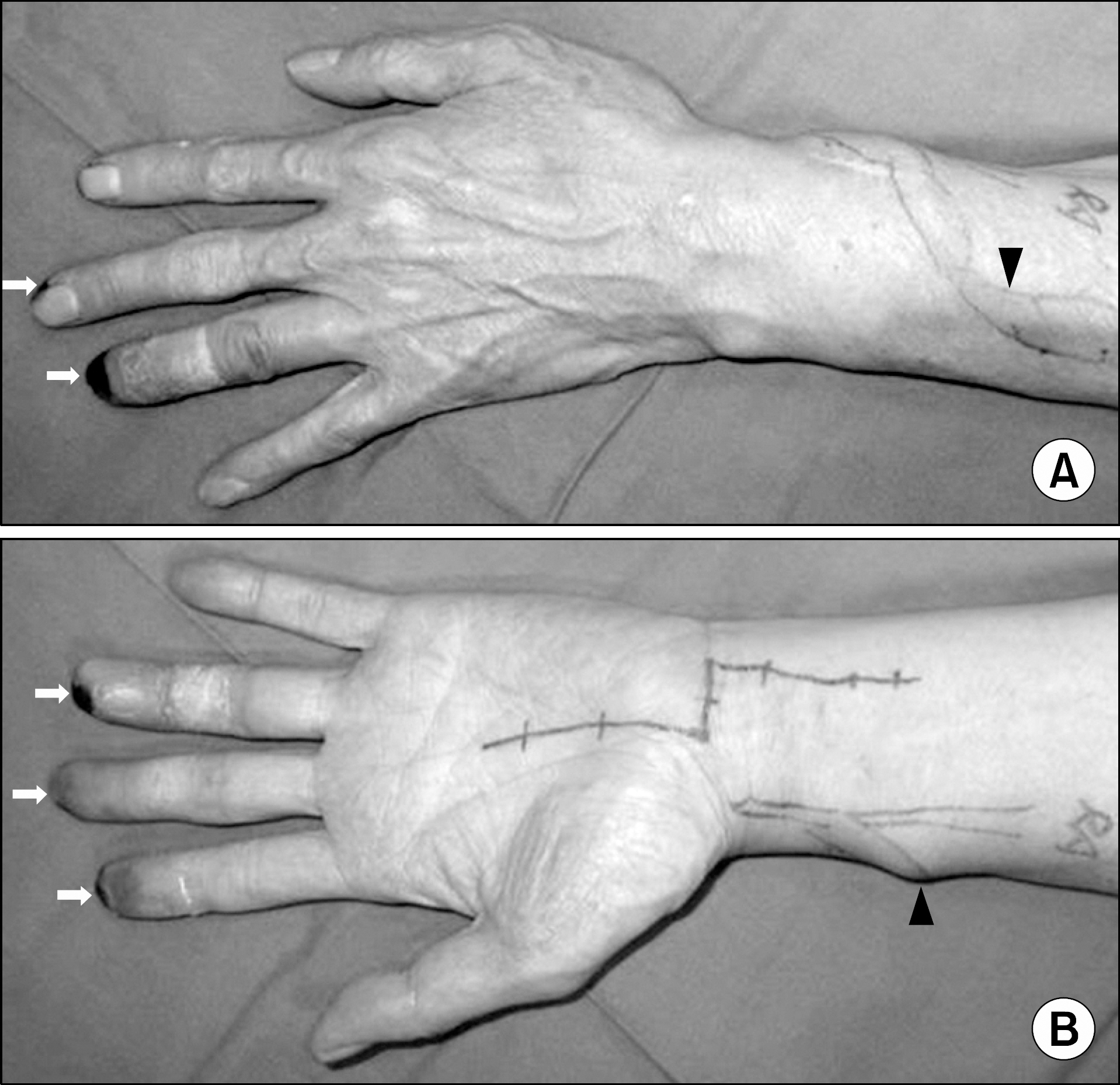J Korean Soc Transplant.
2013 Dec;27(4):190-193. 10.4285/jkstn.2013.27.4.190.
A Case of Ischemic Steal Syndrome in a Renal Transplantation Recipient
- Affiliations
-
- 1Department of Internal Medicine, Hanyang University College of Medicine, Seoul, Korea. sjpjoon@hanyang.ac.kr
- 2Department of Plastic and Reconstructive Surgery, Hanyang University College of Medicine, Seoul, Korea.
- KMID: 1841128
- DOI: http://doi.org/10.4285/jkstn.2013.27.4.190
Abstract
- Ischemic steal syndrome (ISS) is one of the serious complications that can occur after construction of an arteriovenous fistula (AVF) for hemodialysis (HD). Because AVF-related ISS symptoms are usually aggravated during HD sessions, a few cases of ISS in kidney transplantation (KT) recipients have been reported in the literature. We describe a 63-year-old male with diabetic nephropathy who created AVF for maintenance HD and presented with pain at rest and tissue necrosis of the left distal fingers at 10 years post-KT. Brachial angiography revealed the presence of attenuated blood flow through the distal ulnar artery. He underwent finger amputation and AVF ligation, leading to complete relief of ischemic symptoms. The aim of this case report is to help clinicians to diagnosis a steal syndrome in kidney transplantation with a careless AVF for a long period of time.
MeSH Terms
Figure
Reference
-
1). Rocha A, Silva F, Queirós J, Malheiro J, Cabrita A. Predictors of steal syndrome in hemodialysis patients. Hemodial Int. 2012; 16:539–44.
Article2). Zamani P, Kaufman J, Kinlay S. Ischemic steal syndrome following arm arteriovenous fistula for hemodialysis. Vasc Med. 2009; 14:371–6.
Article3). Kim NH. Management of complications in vascular access. Korean J Nephrol. 2006; 25(Suppl 2):530–9. (김남호. 혈관통로 합병증 치료와 관리. 대한신장학회지 2006;25 Suppl 2:530-9.).4). Jin DC. Current status of dialysis therapy in Korea. Korean J Intern Med. 2011; 26:123–31.
Article5). Unger P, Wissing KM. Arteriovenous fistula after renal transplantation: utility, futility or threat? Nephrol Dial Transplant. 2006; 21:254–7.
Article6). Vajdič B, Arnol M, Ponikvar R, Kandus A, Buturović- Ponikvar J. Functional status of hemodialysis arteriovenous fistula in kidney transplant recipients as a pre-dictor of allograft function and survival. Transplant Proc. 2010; 42:4006–9.
Article7). Mickley V. Steal syndrome: strategies to preserve vascular access and extremity. Nephrol Dial Transplant. 2008; 23:19–24.
Article8). Tordoir JH, Dammers R, van der Sande FM. Upper extremity ischemia and hemodialysis vascular access. Eur J Vasc Endovasc Surg. 2004; 27:1–5.
Article9). Lazarides MK, Staramos DN, Kopadis G, Maltezos C, Tzilalis VD, Georgiadis GS. Onset of arterial 'steal' following proximal angioaccess: immediate and delayed types. Nephrol Dial Transplant. 2003; 18:2387–90.
Article10). Sheashaa H, Hassan N, Osman Y, Sabry A, Sobh M. Effect of spontaneous closure of arteriovenous fistula access on cardiac structure and function in renal transplant patients. Am J Nephrol. 2004; 24:432–7.
Article
- Full Text Links
- Actions
-
Cited
- CITED
-
- Close
- Share
- Similar articles
-
- Brachial-ulnar Artery Bypass for Treating Ischemic Steal Syndrome: Report of A Case
- Recurrence of Coronary-Subclavian Steal Syndrome After Successful Angioplasty of Malfunctioning Arteriovenous Fistula
- Subclavian Steal Syndrome
- Gastroduodenal artery steal syndrome treated with coil embolization after orthotopic liver transplantation
- Proximalization of Arterial Inflow for the Treatment of Access-Related Steal Syndrome



